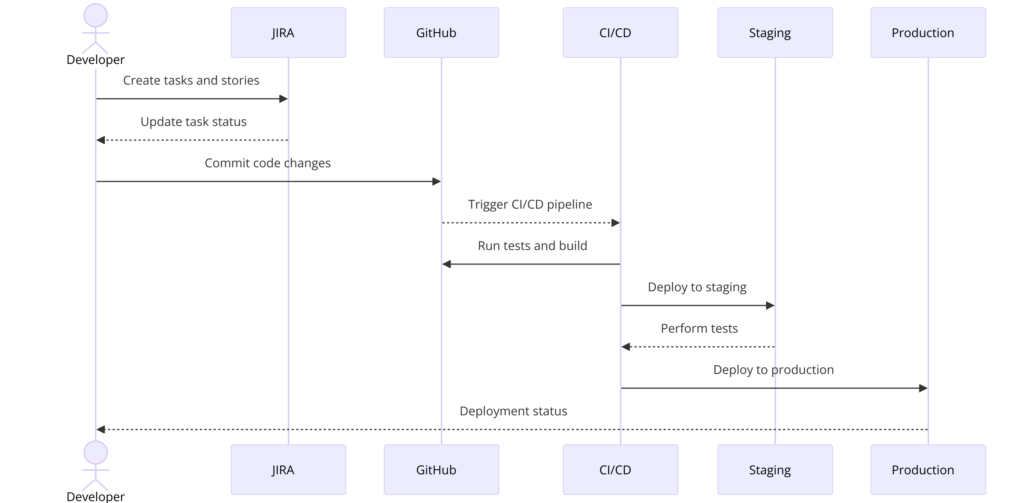
The typical phases of software project management to develop an e-commerce website generally align with the project life cycle phases. Here are the phases:
- Initiation: This phase includes defining the project, obtaining necessary approvals, and assembling the project team. Key activities involve developing a project charter and identifying key stakeholders.
- DevOps: Establish project repositories, set up initial CI/CD pipelines.
- Tools: Git (version control), Jira (project management), Confluence (documentation).
- Planning: Detailed planning is conducted to establish the scope, objectives, and procedures necessary to complete the project. This phase involves creating a project management plan, risk management plan, and defining the project schedule and budget.
- DevOps: Plan infrastructure as code (IaC) setup.
- Tools: Microsoft Project (planning), JIRA (task management), Terraform (IaC).
- Design: In this phase, the technical architecture of the website is created. This includes wireframes, mockups, and detailed design documents specifying how the system will function and look.
- DevOps: Design CI/CD workflows, define infrastructure requirements.
- Tools: Adobe XD or Figma (design), Lucid chart (architecture diagrams).
- Development: This phase involves coding and developing the website based on the design specifications. It includes setting up the backend infrastructure, creating databases, Web API’s, and developing front-end interfaces.
- DevOps: Implement CI/CD pipelines, automated builds, and testing.
- Tools:
- CI/CD: Jenkins, GitLab CI, Circle CI, Travis CI.
- Code Repositories: GitHub, GitLab, Bitbucket.
- Infrastructure: Docker (containerization), Kubernetes (orchestration).
- Programming Languages:
- Backend (API) : Node.js (JavaScript), Django (Python), Ruby on Rails (Ruby), Spring Boot (Java), .NET (C#).
- Frontend: React.js, Angular, Vue.js (JavaScript frameworks).
- Database: SQL (PostgreSQL, MySQL), NoSQL (MongoDB).
- Testing: During this phase, the developed website undergoes various types of testing, such as unit testing, integration testing, system testing, and user acceptance testing, to ensure it meets the required specifications and is free of defects.
- DevOps: Automate testing processes within CI/CD pipelines, implement test-driven development (TDD).
- Tools:
- Testing: Selenium, JUnit, pytest, Jasmine, Mocha.
- CI/CD: Same tools as development phase (e.g., Jenkins, GitLab CI).
- Programming Languages: Same as development phase, with added focus on testing frameworks.
- Deployment: The website is deployed to a live production environment. This phase includes data migration, deployment configuration, and making the website accessible to users.
- DevOps: Continuous Deployment practices, monitoring and logging setup.
- Tools:
- Deployment: AWS (EC2, S3), Azure, Google Cloud Platform (GCP).
- Programming Languages: Deployment scripts may use Shell, Python, or other scripting languages.
- Maintenance: Post-deployment, the website enters the maintenance phase, where it is monitored for performance, security updates are applied, and any issues or bugs reported by users are fixed.
- DevOps: Continuous monitoring, incident response, and regular updates through CI/CD pipelines.
- Monitoring and Logging: Datadog, New Relic, Dynatrace, AWS CloudWatch, Azure Insights.
- Issue Tracking: Jira, GitHub Issues.
- Closure: The project is formally closed, and a final project report is created. This phase involves releasing project resources, archiving project documents, and conducting a post-project evaluation to capture lessons learned.
- Tools: MS Word, Confluence (documentation), Jira (final reporting).
These phases align with both predictive (waterfall) and adaptive (agile) project management approaches. In an agile environment, these phases might overlap, and iterations of development, testing, and deployment can occur frequently throughout the project lifecycle.
Here’s an estimation table detailing the typical percentage allocation of effort for each phase in a software project to develop an e-commerce website. The percentages may vary based on the specific project, team experience, and technology stack, but this provides a general guideline:
| Phase | Percentage of Total Effort |
|---|---|
| Initiation | 5% |
| Planning | 10% |
| Design | 15% |
| Development | 35% |
| Testing | 20% |
| Deployment | 8% |
| Maintenance | 5% |
| Closure | 2% |



